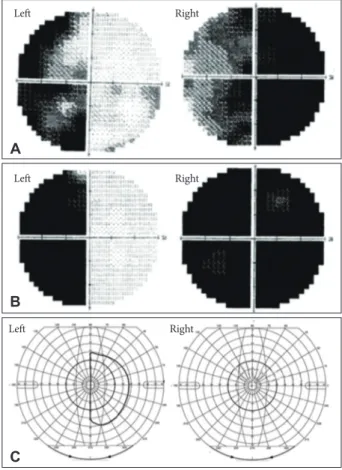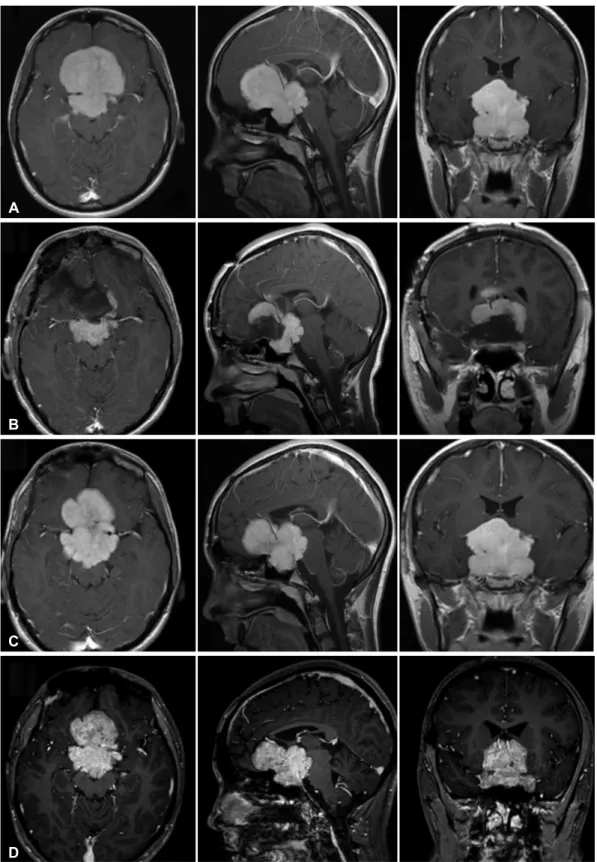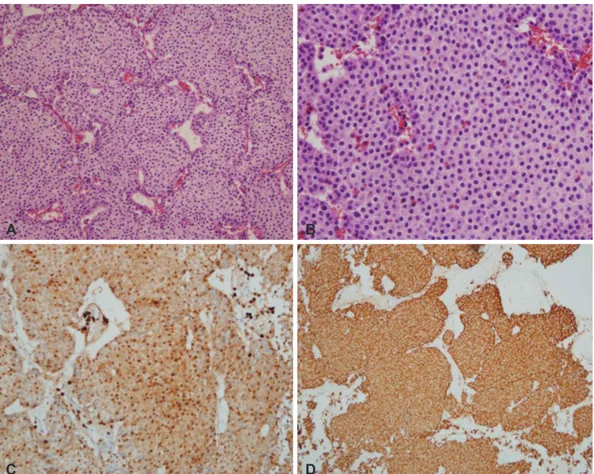INTRODUCTION
Central neurocytoma (CN) is an uncommon benign neu- ronal tumor of the central nervous system (CNS) that is lo- cated in the ventricular system. Nishio et al. [1] reported three cases of unusual neuronal tumors in the cerebral hemisphere and named the tumors “cerebral neurocytoma”. Since the ini- tial report, there have been several case reports of tumors with similar histological features of CNs, but the tumors were lo- cated outside of the ventricles. These so-called extraventricu- lar neurocytomas (EVNs) were classified as a different entity in the 2007 World Health Organization classification of CNS tumors. EVNs have demonstrated more malignant biological behavior, with higher rates of atypia, and higher recurrence rates than CNs [2,3]. In this study, we present an unusual case of hypothalamic EVN in a pediatric patient that mimicked a
Hypothalamic Extraventricular Neurocytoma (EVN)
in a Pediatric Patient: A Case of EVN Treated with Subtotal Removal Followed by Adjuvant Radiotherapy
Minjae Cho1,2, Jin-Deok Joo1,2, Baek-hui Kim3,4, Gheeyoung Choe1,5, Chae-Yong Kim1,2
1Seoul National University College of Medicine, Seoul, Korea
Departments of 2Neurosurgery, 5Pathology, Seoul National University Bundang Hospital, Seongnam, Korea
3Korea University College of Medicine, Seoul, Korea
4Department of Pathology, Korea University Guro Hospital, Seoul, Korea
Received November 11, 2015 Revised March 8, 2016 Accepted March 28, 2016 Correspondence Chae-Yong Kim
Department of Neurosurgery, Seoul National University Bundang Hospital, 82 Gumi-ro 173beon-gil, Bundang-gu, Seongnam 13620, Korea Tel: +82-31-787-7165
Fax: +82-31-787-4097 E-mail: chaeyong@snu.ac.kr
Extra ventricular neurocytoma (EVN) is a rare brain tumor with histologic features similar with a central neurocytoma, but located outside of the ventricular system. In this study, we present an unusual case of hypothalamic EVN in a 14-year-old patient. The patient underwent subtotal removal and had tumor relapse. The patient was then treated using intensity modulated radiation therapy, and the tumor re- mained stable for 24 months. This case report may be important in that this is the first pediatric case of EVN located in the hypothalamic region. EVN has similar radiologic features with pilocytic astrocyto- mas and therefore a hypothalamic EVN may be misdiagnosed as a hypothalamic glioma. Also, the pathologic-radiologic-clinical correlation of EVN located in the hypothalamic area may be different from that of EVNs originating from other usual sites.
Key Words Hypothalamus tumor; Neurocytomas.
hypothalamic glioma.
CASE REPORT
A 14-year-old boy presented with bitemporal hemianopsia and decreased visual acuity at a local hospital (Fig. 1). His vi- sual acuity was decreased to 0.02/0.2 (oculus dexter/oculus sinister). The patient had no specific past medical history. The initial magnetic resonance (MR) image showed a 6.1×5.7×
6.0 cm homogeneously enhanced lobulating mass in the sella and suprasellar areas (Fig. 2). The radiological diagnosis was a hypothalamic glioma. To confirm the pathologic diagnosis a stereotactic biopsy was done. Unexpectedly, the pathologic result was consistent with a neurocytoma. In order to relieve the visual defect and control the disease, the neurosurgeon at the local hospital decided to remove the tumor.
Operation
The surgery was performed by a right fronto-temporal cra- niotomy and subfrontal approach. In the operative field, a flat- tened right optic nerve was noted. During the dissection, the
This is an Open Access article distributed under the terms of the Creative Commons Attribution Non-Commercial License (http://creativecommons.org/licenses/by-nc/3.0) which permits unrestricted non-commercial use, distribution, and reproduction in any medium, provided the original work is properly cited.
Copyright © 2016 The Korean Brain Tumor Society, The Korean Society for Neuro- Oncology, and The Korean Society for Pediatric Neuro-Oncology
tumor origin was not evident, but there was no connection between the tumor and the third ventricle, indicating that this tumor did not originate from the ventricular system. The mass was hyper-vascular, and there were severe adhesions with surrounding structures including the hypothalamus, internal carotid artery, optic nerve, and optic chiasm. Due to these find- ings, aggressive dissection and removal of tumor was limited and subtotal removal was performed. Approximately, 60% of tumor was removed. There was remnant tumor mass in the hypothalamus and optic nerve at the midline and left side, respectively (Fig. 2).
Pathologic findings
The histological findings of the tumor were identical to those of a CN (Fig. 3). The tumor was composed of homogeneous cells with clear and round cytoplasm, honeycomb appearance, and mild nuclear pleomorphism. The immunohistochemis- try results were positive for synaptophysin and chromogranin.
Ki-67 labeling index was less than 1%. There was no evidence of connections between the tumor and ventricles according to the radiological and surgical findings. Therefore, the patho- logic diagnosis was an EVN.
Postoperative course
The patient’s visual acuity of left eye somewhat recovered to 0.7 from 0.2. The visual field defect of the right eye was not improved, and the visual acuity of the right side actually de- creased to hand motion perception (Fig. 1). However, MR im- aging taken at one-year follow-up after surgery revealed a 6.0×
4.4 cm enhancing mass. This mass was a re-growing tumor from the sub-totally resected tumor (Fig. 2). The visual acu- ity was aggravated to no light perception on the right side and 0.5 on the left side. The neurosurgeon decided to perform radiotherapy with low dose radiation. He treated the patient with intensity modulated radiation therapy (IMRT) giving 200 cGy over 10 fractions to the relapsed tumor. The patient was then referred to our institution. We made a decision to continue the radiotherapy as a salvage therapy for three weeks with IMRT. The patient was treated with 30 Gy delivered in 15 fractions to the tumor. A follow-up MR was taken 24 months after the IMRT, and the results showed that the tumor was stable. The visual field has also remained unchanged accord- ing to the serial Goldmann perimetry exam (Fig. 1).
DISCUSSION
The incidence of pediatric EVN is so low that the incidence has been estimated only from a number of case reports and series. A review of pediatric EVNs in the PubMed database provided about 50 cases [3-5]. However, to our knowledge,
there has been no case report of a pediatric EVN located in the hypothalamic region. The present case provides the first detailed radiological and clinical features of a pediatric hypo- thalamic EVN.
However, the importance of this case is not restricted to its rare location, but rather related to the risk of misdiagnosis, when facing a hypothalamic mass in pediatric patients. In in- cidence-wise aspect, primary brain tumors in the hypotha- lamic area comprise approximately 10% of all primary brain tumors in the pediatric population [6]. Gliomas of the optic pathway and the hypothalamus account for approximately 5%
of all pediatric brain tumors, and up to 85% involve the hypo- thalamus [7]. In radiological terms, EVNs are often well-de- marcated, partly or mainly cystic, and variably enhancing masses, with or without peritumoral edema [8]. Gliomas of the optic pathway and the hypothalamus also show similar ra- diologic findings [9]. In other words, EVNs may resemble pi- locytic astrocytomas, gangliogliomas, or oligodendrogliomas [8]. Pediatric EVNs have been located mostly in the cerebral hemisphere, especially the frontal lobe. Unusual intracranial
Left
Left
Left
Right
Right
Right
A
B
C
Fig. 1. The results of the Humphrey visual field exam (A) revealed
“bitemporal hemianopsia”, preoperatively. The same exam (B) was performed when regrowth of the tumor was confirmed, and showed the same pattern with almost complete right eye blindness. After radiotherapy, there was no aggravation of the visual field accord- ing to the Goldmann perimetry exam (C). However, the right eye was unable to perceive light.
locations of EVNs include the thalamus, cerebellum, and spine [4]. There has been no case report of a pediatric EVN lo- cated in the hypothalamus. Thus, a pediatric neurosurgeon
could misdiagnose a hypothalamic EVN as a hypothalamic glioma. Because the treatment of hypothalamic gliomas is somewhat different from that of hypothalamic EVNs, pediat-
Fig. 2. T1-gadolinium-enhanced axial, sagittal, and coronal MR images showing the well-demarcated and homogeneously enhanced mass lo- cated in the sella-suprasella-hypothalamic area. A: Preoperative images. B: Immediate postoperative images. C: Postoperative images taken 1 year after the surgery showing regrowth of the tumor. D: The last follow up taken 24 months after intensity modulated radiation therapy.
A
B
C
D
which can give important information for neurosurgeons developing a treatment plan for a pediatric hypothalamic EVN.
In conclusion, EVNs has similar radiologic features with pilocytic astrocytomas, such that hypothalamic EVNs may be misdiagnosed as a hypothalamic glioma. Also, the patho- logic-radiologic-clinical correlation of EVNs located in the hypothalamic area may be different from that of EVNs origi- nating from other usual sites.
Conflicts of Interest
The authors have no financial conflicts of interest.
REFERENCES
1. Nishio S, Takeshita I, Kaneko Y, Fukui M. Cerebral neurocytoma. A new subset of benign neuronal tumors of the cerebrum. Cancer 1992;
70:529-37.
2. Sweiss FB, Lee M, Sherman JH. Extraventricular neurocytomas. Neu- rosurg Clin N Am 2015;26:99-104.
3. Xiong Z, Zhang J, Li Z, et al. A comparative study of intraventricular central neurocytomas and extraventricular neurocytomas. J Neurooncol 2015;121:521-9.
4. Han L, Niu H, Wang J, et al. Extraventricular neurocytoma in pediatric populations: a case report and review of the literature. Oncol Lett 2013;
6:1397-405.
5. Patil AS, Menon G, Easwer HV, Nair S. Extraventricular neurocytoma, ric neurosurgeons should be well aware of the fact that there
could be a hypothalamic EVN in pediatric patients.
Atypical EVN is defined as an EVN with atypical histologic features including increased proliferative index, microvascu- lar proliferation, or necrosis. An atypical EVN is regarded as a more aggressive variant, so that it is helpful to predict wheth- er the lesion is atypical or not before surgery [10]. According to a recent report, atypical histologic features seems to corre- late with radiologically aggressive findings, e.g., vascular pro- liferative patterns and infiltrative margins [11]. This report reviewed an atypical pediatric EVN, among which there have been no hypothalamic EVNs. On contrast-enhanced MRI, the EVN of our case shows a well-demarcated homogeneously enhanced mass (Fig. 2), which did not indicate atypical pa- thology. In the pathologic examination, the tumor showed benign features, including Ki-67 index <1%. However, the findings during operation showed hyper-vascularity and se- vere adhesion with surrounding structures. Also, despite the benign pathologic and radiologic features, the tumor in our case grew somewhat rapidly after subtotal resection. There- fore, radiologic and pathologic features of EVN in the hypo- thalamic area may not correlate well with the clinical features,
Fig. 3. Histopathology of the lesion resected during the craniotomy. A and B: Hematoxylin and eosin staining indicates a tumor of moderate cellularity with vascular proliferation. Immunohistochemistry demonstrates neoplastic cells exhibiting strong, diffuse immunoreactivity for (C) chromogranin and (D) synaptophysin.
A
C
B
D
a comprehensive review. Acta Neurochir (Wien) 2014;156:349-54.
6. Schroeder JW, Vezina LG. Pediatric sellar and suprasellar lesions. Pe- diatr Radiol 2011;41:287-98; quiz 404-5.
7. Alshail E, Rutka JT, Becker LE, Hoffman HJ. Optic chiasmatic-hypo- thalamic glioma. Brain Pathol 1997;7:799-806.
8. Yang GF, Wu SY, Zhang LJ, Lu GM, Tian W, Shah K. Imaging findings of extraventricular neurocytoma: report of 3 cases and review of the lit- erature. AJNR Am J Neuroradiol 2009;30:581-5.
9. Koeller KK, Rushing EJ. From the archives of the AFIP: pilocytic as-
trocytoma: radiologic-pathologic correlation. Radiographics 2004;24:
1693-708.
10. Kane AJ, Sughrue ME, Rutkowski MJ, et al. Atypia predicting prognosis for intracranial extraventricular neurocytomas. J Neurosurg 2012;116:
349-54.
11. Kawano H, Kimura T, Iwata K, et al. Atypical extraventricular neurocy- toma in a 3-year-old girl: case report with radiological-pathological cor- relation. Childs Nerv Syst 2015;31:1189-93.


